Birdfeeders in North America attract a wonderful variation of little brown birds. There are, in fact, several different species of North American birds that may make an appearance at your feeder and identifying between them isn’t always easy.
This list considers the 12 most common little brown birds that are attracted to backyard birdfeeders in the United States.
We cover the key characteristics of each bird, which will hopefully help you note the small differences between each one to recognise which little brown bird it is that you see.
1. Female House Finch
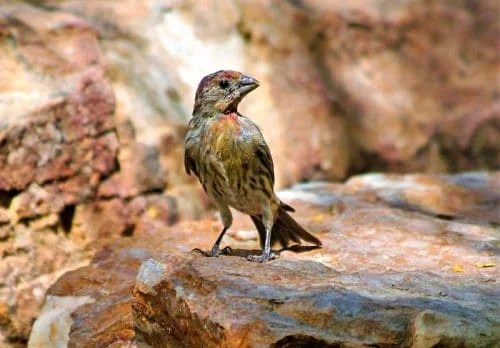
Finches are indeed regular visitors to feeders. The Female House Finches are petite brown birds and are notably slender and have short wings.
Their tails, however, are rather long and narrow. These birds are a brown colour, with some stark red detailing on their breasts and forehead. Sometimes, this rosy tint may appear orange or yellow, but it is a very helpful characteristic to identify the species.
They range across most of the United States, particularly on the Western coast, although they are most commonly found in Canada.
You can find these finches in their native habitats of woodlands, grasslands and residential areas. They often perch on tree branches, where they tend to hide from bushes that are infiltrated by other sparrows.
These birds also nest near buildings and are very much attracted to feeders. In fact, these birds are most likely to be the most common little brown birds found at feeders and they prefer tube feeders with sunflower seeds.
To learn more about the House Finch you can visit: https://www.audubon.org/field-guide/bird/house-finch
2. Fox Sparrow
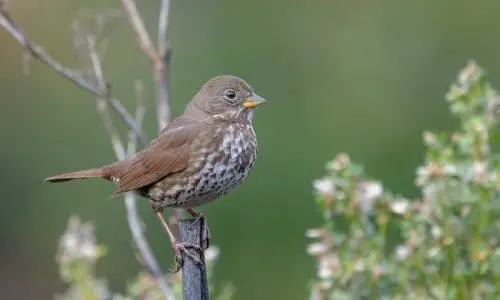
Summertime is the prime season to spot these sparrows. They are large, stocky sparrows, that prefer to reside along the Rocky Mountains and the West coast, particularly in and around California year-round. In winter, these birds hide amongst dense shrubbery, only appearing when other birds have left.
Summertime sees these sparrows favouring mountain landscapes and some open forests.
These sparrows are similar in appearance to the Song Sparrow.
They are a pale grey-brown colour, with some reddened feathers on their wings and plumages. One notable characteristic of this species is their big bills and prominent streaking on their underparts.
These sparrows feed primarily on the ground, and can be drawn to the foot of bird feeders where there are some spilled seeds.
To learn more about Fox Sparrow you can visit: https://www.audubon.org/field-guide/bird/Fox-Sparrow
3. Song Sparrow
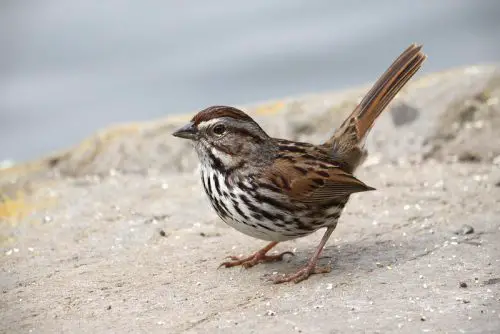
These birds are medium-sized sparrows, identified primarily by their particularly rounded and elongated tails. They can, however, be quite difficult to identify, as the appearance, size and colouring of the birds in the species vary greatly.
Some Song Sparrows appear paler than others, often those found in Southern California. All of these birds, however, have predominantly grey faces, with a white-grey stripe above their eyebrows.
These birds also have additional stripping along the sides of their throats, which may help with identification.
The rage of this species extends across much of the United States.
They tend to favour moist and shrubby habitats, as well as hedges and garden bushes. Song Sparrows are also commonly found at the foot of birdfeeders.
They tend to eat small seeds and fruit, as well as small insects in summer. Winter is generally the best season to spot these birds near feeders, as during summer they spend much of their time hunting for insects.
To learn more about Song Sparrow you can visit: https://www.audubon.org/field-guide/bird/song-sparrow
4. American Tree Sparrow
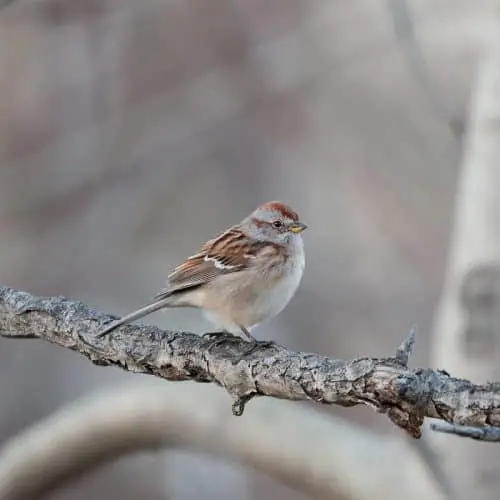
These sparrows are small, greyish birds with brown and white detailing on their backs and white wing bars. They have round heads with some reddish feathers on the crown.
Another detail to look out for is a dark spot on their breast as well as their short, squared tails. American Tree Sparrows are often found in flocks, sometimes mixing with other sparrows.
They can be attributed to treelines and grassy habitats surrounding forests, particularly during winter.
These birds can be found across most of the United States and are likely to visit bird feeders with small seeds like millet. They do, however, prefer to stay on the ground eating seeds that have fallen from feeders.
To learn more about American Tree Sparrow you can visit: https://www.audubon.org/field-guide/bird/american-tree-sparrow
5. Female Red-winged Blackbird
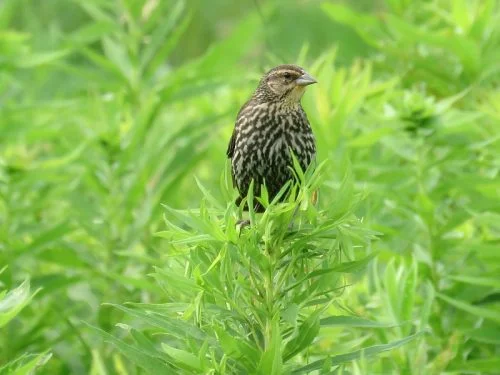
These birds are year-round residents of the U.S. and are very frequent visitors to feeders. They are small, yet stocky birds with very short tails and rounded bellies.
They are indeed brown birds, but they have red-orange detailing on their wings and some yellow flakes along their shoulders.
These birds are larger than sparrows but are still rather petite in size and have sharp, pointed bills. Their brown feathers are stripped with a pale grey pigment as well as some white streaks. Some birds also have pink-orange throats.
Female Red-winged Blackbirds favour moist habitats, particularly wet fields and marshes. They are known to form large flocks, especially in winter, that can be found in fields and open residential areas.
Deserving of their place in this list, these birds are frequent visitors of birdfeeders, where they eat mostly millets, sunflower seeds and often some corn.
To learn more about Red-winged Blackbirds you can visit: https://www.audubon.org/field-guide/bird/red-winged-blackbird
6. White-crowned Sparrow
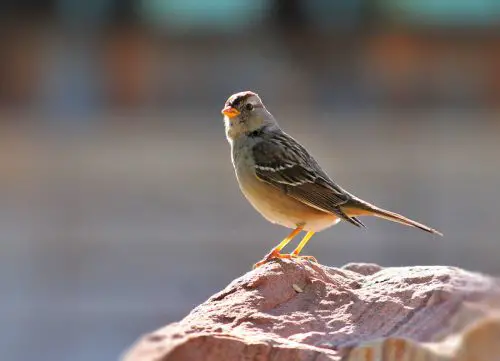
Breeding across the West coast of the United States, these sparrows are stunning little brown creatures that are also likely to visit birdfeeders.
White-crown Sparrows can be identified mainly by their namesake white stripped crowns, with some adult males also demonstrating some black stripping on the crown too.
They have grey bodies, like many other sparrows in this list, but have distinctive brown stripes along their backs and wings.
They also have bigger tails than other sparrows, that are often darker than the rest of their bodies. White-crowns Sparrows also have yellow, and often pink, bills.
The coast of California is known to be home of much of North America’s White-crowned Sparrows, although some of the variants of the species may reside further South and winter in Southern states as well as further into Central America.
These birds can be found along roadsides in bushes and on lawns, often in large flocks. You may expect to find that these sparrows are more likely to visit birdfeeders on the West coast as opposed to anywhere else in the U.S. They are draws to millet and sunflower seeds near feeders.
To learn more about White-crowned Sparrow you can visit: https://www.audubon.org/field-guide/bird/white-crowned-sparrow
7. Female Brown-headed Cowbird
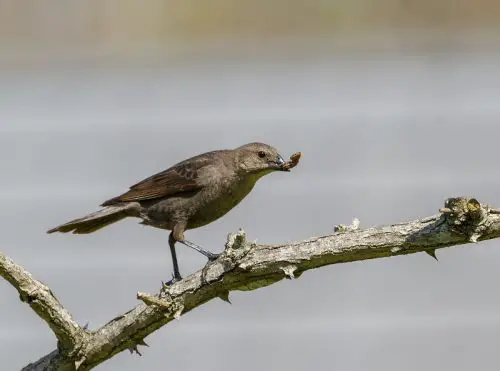
Another species of little brown birds that is known to visit feeders is the Female Brown-headed Cowbird. These birds are native to much of the U.S. and most commonly in residential areas on the West coast.
They are small blackbirds, known for their flat heads and short necks and striking black feathers.
Their heads are washed in a chestnut brown, which also streaks down along their sides, intertwining with the blackened feathers on their backs.
Their underparts are notably paler than the rest of their bodies.
Cowbirds are attributed to open woodlands, as well as grasslands near residential areas, particularly during winter. The winter season is the most common time for these birds to visit feeders, as well as in Spring whilst the birds are migrating North towards Canada.
Much like the other birds in this list, they can be attracted to feeders with millet seeds and tend to hop on the ground by the foot of the feeder.
To learn more about Female Brown-headed Cowbird you can visit: https://www.audubon.org/field-guide/bird/brown-headed-cowbird
8. Bewick’s Wren
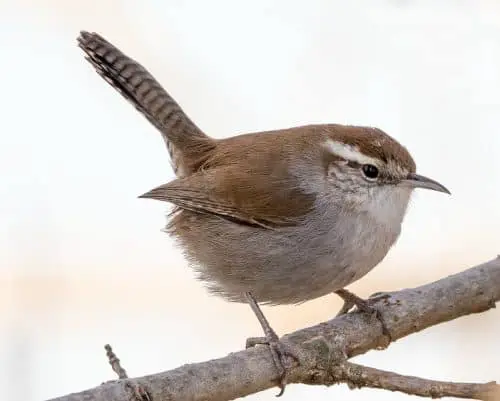
These wrens are particularly small creatures, smaller than the average sparrows and have very plump, round bodies. Their bodies are so distinctively plump that they appear to not have a neck, and they have curved bills which appear longer than many birds.
These birds also have distinctively floppy tails, which often stick up behind their heads. Being little brown birds, they appear similar to others in this list.
They do, however, have rather pale grey underparts which is an integral factor to help identify them. The rest of their feathers appear brown, sometimes reddish, and they have large eye stripes.
Bewick’s Wrens are residents of the Pacific Coast year-round, often too further into Texas, particularly during breeding seasons.
Their habitats include dense woodlands, deserts, riversides and, most importantly, backyard hedges where they often retreat to after visiting feeders.
To learn more about Bewick’s Wren you can visit: https://www.audubon.org/field-guide/bird/bewicks-wren
9. White-throated Sparrow
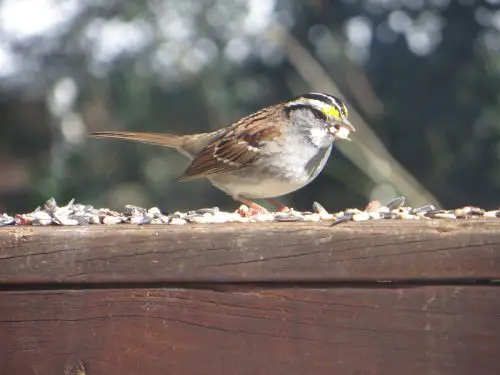
In breeding season, these birds are likely to be found in the North of the U.S., as well as further South in the winter. It is somewhat rare to spot these birds on the West coast during winter.
White-throated Sparrows prefer forests and dense woodland habitats, especially during breeding season.
They often favour forests within close proximity of birdfeeders, and are often found hoping on the ground searching for food. At bird feeders, particularly on the East coast, these birds become regular visitors, feeding on sunflower seeds and millets primarily.
The birds are dark grey on their throats and their sides, with a chestnut brown on their upper parts and a pale grey head that is stripped in brown and white.
They have a unique yellow spot on their foreheads which is a key identifying factor.
To learn more about White-throated Sparrow you can visit: https://www.audubon.org/field-guide/bird/white-throated-sparrow
10. Golden-crowned Sparrow
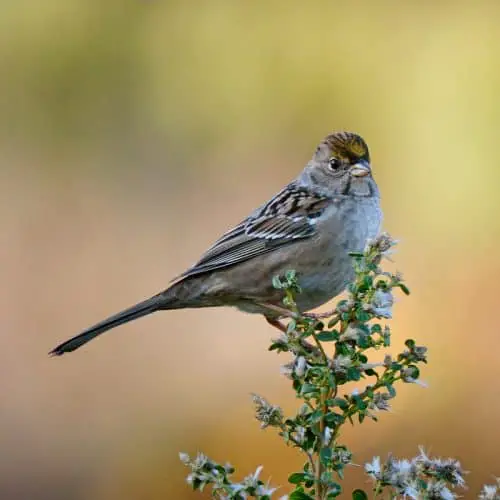
Another sparrow that is no stranger to birdfeeders is the Golden-crowned Sparrow. These sparrows are large and stocky, with large heads and elongated tails.
Their colouring is a rather pale grey, with some brown interlaced in the feathers on their backs and wings. They also have very large bills, as well as a namesake yellow crown streaked with blackish-brown markings.
These birds can be attributed to much of the U.S. but are most commonly found on the West Coast during summertime.
They are rather reserved birds, residing in dense, brushy forests in large flocks and only forage when it’s quiet. However, they do in fact visit feeders, particularly those that have a low platform or are situated on the ground. They, like many others in this list, feed on seeds and fruit, namely sunflower seeds and millets.
To learn more about Golden-crowned Sparrow you can visit: https://www.audubon.org/field-guide/bird/golden-crowned-sparrow
11. Female Purple Finch
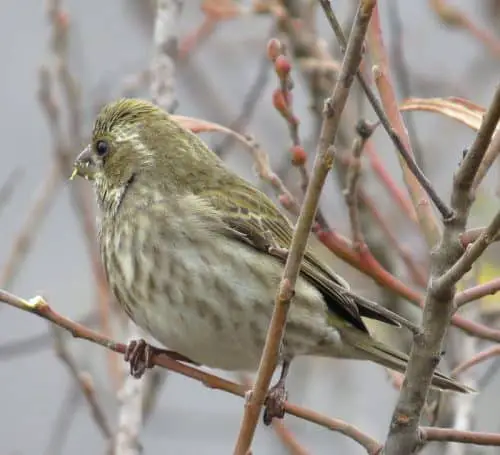
These finches are stunning creatures, and regular visitors to feeders.
Despite their given name, they are also in fact brown birds, but have a unique colouring in their feathers which helps with identifying the species. Female Purple Finches are a wonderful display of colour, with brown feathers streaking across their tails and upper bodies, as well as reddish-purple feathers across their breasts and on their heads.
They also have distinctive markings on their face, with some black-brown details extending from eyebrow to ear and towards the neck. They are rather plump birds in comparison with other Finches, with large heads and bills.
These birds can be found in much of North-eastern U.S. as well as Western states such as California whilst breeding, primarily in spring and summer.
They reside in forests as well as in residential areas. Winter is the most common season to spot them at birdfeeders and they are particularly drawn to tube feeders with sunflower seeds.
To learn more about Female Purple Finch you can visit: https://www.audubon.org/field-guide/bird/purple-finch
12. House Sparrow
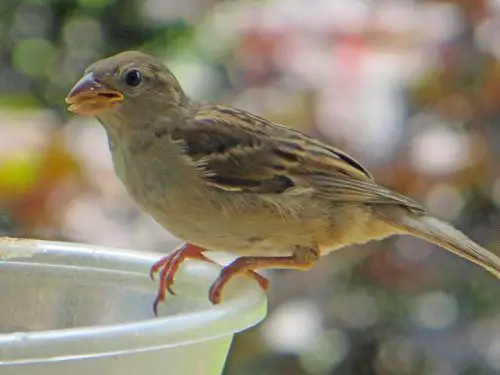
These little brown birds are small and stunning creatures, as well as regular birdfeeder visitors. You may notice that these birds have greyer plumages, with some grey extending from the rump to the tail too.
Like other little brown birds alike, they have light brown feathers across their wings, appearing almost chestnut-like in colour in the sun.
A key element to look out for is their stark white wing bar, as well as some black detailing on their faces. They also tend to have rather broad upper-bodies and small, stocky legs, which may be key in identifying them.
In addition to being particularly small birds, they also have very flat heads, which may also sometimes appear a grey colour.
House Sparrows are found across much of North America’s landscape, and do not migrate.
They are very much creatures of small towns and communities that are highly populated and can be found in most of the United States during summertime.
For this reason, they are very attracted to birdfeeders. Look out for their noisy calls, as they are very loud and active birds, often found in medium to large flocks. They feed primarily on small seeds in feeders and also anywhere near the ground as they tend to hop around on the ground.
To learn more about House Sparrow you can visit: https://www.audubon.org/field-guide/bird/house-sparrow
